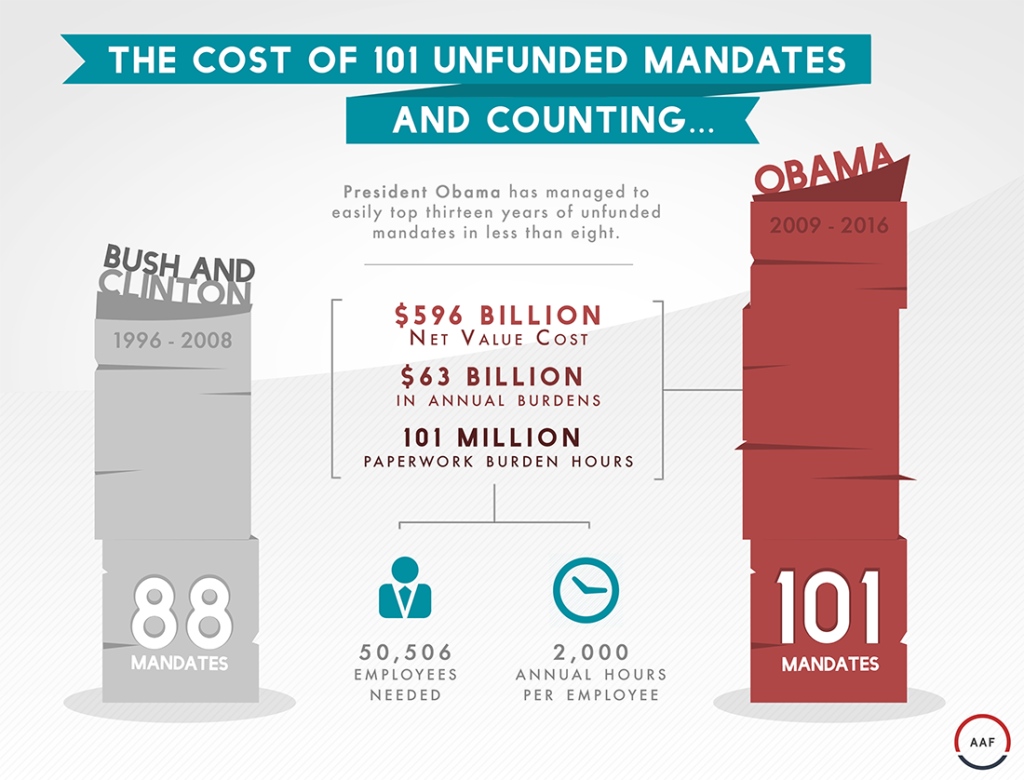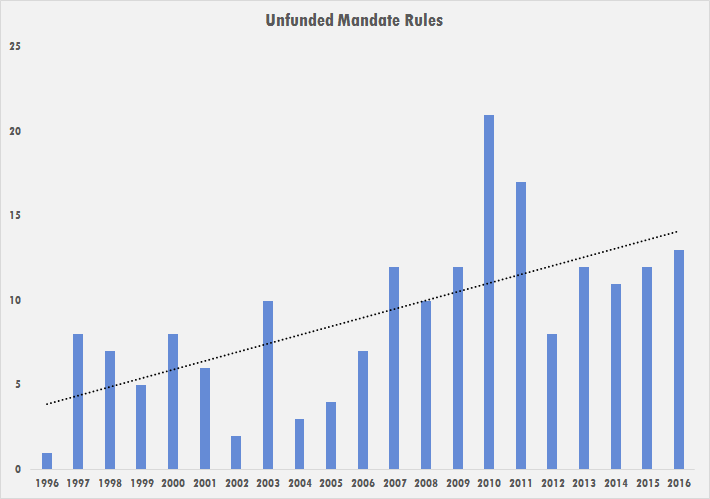Insight
October 7, 2016
101 Unfunded Mandates and Counting

The Obama Administration has set several notable records in the regulatory world: 600 major regulations and counting, more than 10 billion hours of federal paperwork, and the costliest single year in regulation in recent history. It’s time for another record: 101 unfunded regulatory mandates imposed on states, local governments, and businesses. From 1996 to 2008, since the inception of the Unfunded Mandates Reform Act (UMRA), which establishes a regulatory procedure for these federal mandates, there were only 88. Broadly, an unfunded mandate is defined as a regulation, without explicit Congressional consent or adequate federal funding, which may displace state or local priorities. President Obama managed to easily top 13 years of unfunded mandates in less than eight. See below.
|
Administration |
Number of Unfunded Mandates |
|
President Obama |
101 |
|
President Bush |
56 |
|
President Clinton |
32 (64 projected) |
The American Action Forum (AAF) last examined the paperwork side of unfunded mandates in 2015 and found $35 billion in costs to the states, with 75 million paperwork hours. However, these UMRA regulations go beyond just paperwork. The regulatory trend above is unmistakable. In 2010, regulators published 21 rules with unfunded mandates on states or private entities. From 2002 to 2005, the Bush Administration imposed 19; from 1996 to 1999, the Clinton Administration also managed 21 rules. With 13 regulations and counting this year, it is possible the administration could approach its record from 2010.
What is the cost of these unfunded mandates? $596 billion in net present value costs, $63 billion in annual burdens, and 101 million paperwork burden hours. For perspective, it would take 50,506 individuals employed by states and businesses (working 2,000 hours annually) to complete a single year of these new paperwork requirements. These figures also include a final rule that reduces burdens by $605 million and cuts paperwork by 21 million hours. Another regulation related to removing “Country of Original Labeling” for beef and pork cut $1.8 billion in costs, but the administration did not label it under UMRA. There are also 13 regulations that did not monetize costs or where costs would be duplicative of other joint rulemakings (for example, vehicle efficiency standards from the Environmental Protection Agency and the Department of Transportation). Regardless, the individual share (per capita) of these unfunded mandates is $1,842 for every person in the U.S.
Here are the top five unfunded regulatory mandates on business and states during the Obama Administration.
|
Largest Unfunded Mandates |
|||
|
Regulation |
Total Cost |
Annual Cost |
Paperwork Hours |
|
$156 billion |
$10.8 billion |
5,667 |
|
|
$51.8 billion |
$4.9 billion |
39,940 |
|
|
$31.5 billion |
$1.9 billion |
56,833 |
|
|
$27.3 billion |
$1.5 billion |
||
|
$23.2 billion |
$509 million |
369,837 |
|
For specific regulations imposed on states and local governments, there were only four listed, due to the number of exemptions in UMRA for regulatory activity:
- Nondiscrimination on the Basis of Disability: $12.9 billion
- Real-Time System Management Information: $1.4 billion
- Nutrition Standards for National School Lunch Program: $125 million
- Rules for Group Health Plans: $83 million
The total tally for these four regulations is $14.5 billion imposed on states and local governments. That is largely in addition to the more than $35 billion in new paperwork costs added since 2009. Thus, the total imposition on states during the past eight years approaches $50 billion in unfunded regulatory burdens. These haven’t all occurred annually and there are other rules outside of these four that will impose burdens on local governments, but there will be a lasting legacy on state budgets because of new regulation. Notice, the Clean Power Plan is not considered an unfunded mandate by EPA. However, few believe state governments won’t incur unfunded costs to implement the sweeping new regulation.
Strangely, a much larger school lunch rule from 2012, which imposed $3.2 billion in total burdens on states, was not classified as an unfunded mandate. This is odd because the rule itself and the Government Accountability Office (GAO) report that the regulation does indeed impose unfunded mandates on states and local governments. As GAO noted, “This final rule contains federal mandates that could result in costs to state, local, or tribal governments or to the private sector of $100 million or more in any one year.” So, the actual tally should be 102 unfunded mandates and counting for the administration.
Reform?
As noted, there are several rules that many would consider as unfunded mandates, but nevertheless escape scrutiny under UMRA. This is because the law is riddled with exemptions that regulators routinely exploit. GAO has found “14 reasons why a rule would not be identified as containing a federal mandate.” Agencies heavily leverage these 14 exclusions and exemptions, including one that allows an agency to issue an interim or direct final rule, avoiding UMRA scrutiny.
In terms of reform, Congress has three bills that seek to change the UMRA process. H.R. 50, which has already passed the House, would allow Congress to request a retrospective review of an existing regulation, create judicial review under UMRA, expand the definition of “direct costs,” and apply the law to independent agencies, which are now exempt from oversight. S. 2570 largely parallels the reforms for H.R. 50 and adds a component requiring agencies to select the “least costly, most cost-effective, or least burdensome [regulatory] alternative.” Finally, there is a targeted bill that would apply UMRA to independent agencies. All of these measures would narrow the 14 exemptions and exclusions in UMRA and shed more light on unfunded regulatory mandates.
Conclusion
101 unfunded mandates and counting. By Inauguration Day next year, that number will surely to grow. It’s not just a number; the impact of that many unfunded mandates equates to more than $596 billion in total costs and 101 million paperwork burden hours. UMRA was designed to provide transparency and the ability to limit unfunded mandates. Arguably, on both fronts, it has failed. It’s clear states and local governments will wrestle with the implications of these regulations for years to come.












